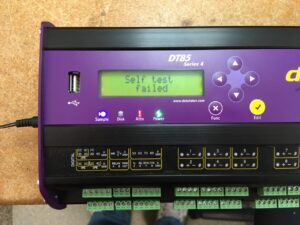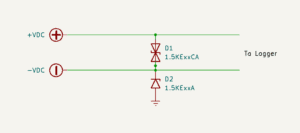 We occasionally receive data loggers in for repair that fail their internal self-test. This usually indicates damage to either the internal power supply circuits or to the amplifier/A/D converter. Recently, we received multiple units back from one customer that shared a similar problem with the main power supply. Going back to the customer, we found out that these were all being used to monitor an open pit mine. Since the loggers were in the field, they were powered by solar panels. The customer said there had been a particularly intense lightning storm at the site which, in addition to the data loggers, had also damaged the solar charge controller. Upon disassembling the loggers we found several of the inductor filters in the power supply were vaporized! This was an obvious indication of a very large and very fast voltage transient on the incoming power. We’ve seen similar damage in the past, sometimes in the power supply and sometimes in the input circuitry including the input relays or multiplexers.
We occasionally receive data loggers in for repair that fail their internal self-test. This usually indicates damage to either the internal power supply circuits or to the amplifier/A/D converter. Recently, we received multiple units back from one customer that shared a similar problem with the main power supply. Going back to the customer, we found out that these were all being used to monitor an open pit mine. Since the loggers were in the field, they were powered by solar panels. The customer said there had been a particularly intense lightning storm at the site which, in addition to the data loggers, had also damaged the solar charge controller. Upon disassembling the loggers we found several of the inductor filters in the power supply were vaporized! This was an obvious indication of a very large and very fast voltage transient on the incoming power. We’ve seen similar damage in the past, sometimes in the power supply and sometimes in the input circuitry including the input relays or multiplexers.
It doesn’t take a direct hit by lightning to cause this kind of damage resulting in a “self-test failed” message. A cloud-to-ground lightning bolt is actually a multiple-step process, involving an initial leader from the cloud, a streamer from the ground upward towards the cloud, the connection of these two to form a low resistance ionized path cloud to ground, and then the main discharge from the cloud to ground which is the lightning bolt we see. This main stroke averages 30,000 amps, lasts only 10’s microseconds, and travels at up to 1/3 the speed of light. Also, most of the time it is not a single bolt but actually 3-4 individual bolts milliseconds apart. As the current discharges into the earth, it creates very large voltage variations along the surface as it spreads out which is the cause of the majority of injuries associated with lightning. Also because of the very large current and the fast transient, there is a large electromagnetic pulse associated with the strike. This pulse can induce large voltages in conductors near the strike. If you have had a radio or TV blown out by lightning, it was probably because of this as opposed to a direct hit.
So now, what about the question behind this whole post, “what can I do to prevent or at least reduce the possibility of this type of damage?” It turns out that there is a whole class of protection devices that were designed exactly for this application. They are called transient voltage suppression or TVS diodes. A popular model is the Littlefuse 1.5KE Series. They act as open circuits until the voltage across them increases to the specified clamp voltage at which point they turn on and act as a short circuit. The response time is very fast as short as 1 picosecond. This particular family of devices can handle a current pulse of up to 200 amps and if the current is greater than that they typically fail as a short circuit. They are available in a range of clamp voltages from 6.8 up to 500 volts. Also, they come in unidirectional and bi-directional models.
To use them on an analog input signal, I usually recommend a “belt and suspenders” approach to provide both protection to ground and protection across the + and – signal lines as shown in figure 1. Since the signal lines are often floating or isolated from ground, the 2 unidirectional TVS diodes to ground prevent either of the signal lines from exceeding the common mode voltage limit of the data logger. The bidirectional TVS between the signal lines prevents the differential voltage between the = and – from getting large enough to cause damage to either the input multiplexers or the signal conditioning and A/D circuits. For the clamping voltage for the diodes, select a value that is a couple of volts greater than the normal operating voltage of the circuit. For example, if you are using thermocouples where the signal voltage is on the order of millivolts, the lowest value available, 6.8 volts should be OK. If you have a 4-20 mA loop powered by a 24 VDC supply then use a value closer to 30 volts.

Figure 1 TVS Protection for Analog Inputs
You should also provide protection on the incoming power to the loggers to prevent the sort of damage that was described before. Figure 2 shows one recommended configuration. This will protect both from the excessive voltage across the power lines and from the incoming power to ground. If the low side of the incoming DC power is already connected to ground, TVS D2 can be eliminated. Again, the clamping voltage for diode D1 should be a few volts above the nominal power supply voltage and D2 should be as low as possible.

Figure 2 TVS for DC Power Supply
Well, there you have it, my recommendations on what you should do to prevent the next lightning storm from causing the dreaded “Self-Test Failed” error message on your data logger.


Leave a Reply
You must be logged in to post a comment.